Same Difference: 2022/23 Position of the Season / Part Two
In a season characterized by unprecedented upheaval for Bayern Munich, their campaign finished with an all-too-familiar flourish, securing their 11th consecutive Bundesliga title. Despite Bayern winning their league while Arsenal finished as runners-up, many would suggest Arsenal had a better 22/23 season than Bayern did given their respective pre-season expectations.
Bayern entered last season without the talismanic Robert Lewandowski leading their line for the first time since 2014, a change that was always going to require some adjustment. Bayern were seemingly able to put some early season inconsistency behind them, finding a rich vein of form in early 2023 after the World Cup break. In late March, however, Bayern abruptly sacked head coach Julian Nagelsmann and replaced him with Thomas Tuchel.
Tuchel took over a team still competing for a treble and within his first month oversaw Bayern’s elimination from both the Champions League and DFB-Pokal (German cup). Bayern ultimately sealed their title in dramatic fashion in the final minutes of the season, bailed out in equal parts by a moment of individual brilliance from Jamal Musiala and Borussia Dortmund’s inability to win their final league fixture at home to Mainz.
Musiala often played a leading role when Bayern were performing well throughout the 22/23 season, and analyzing his role in midfield highlights some stark parallels between Arsenal and Bayern’s respective set-ups.
Bayern-Arsenal Analogue: Roles of Musiala and Goretzka
Jamal Musiala and Leon Goretzka were deployed as 8s (at least on paper) at various points throughout Bayern’s season, lined up on either side of Joshua Kimmich in a three-man midfield. Musiala’s potency as one of Bayern’s key creative sparks was complemented by Leon Goretzka’s more disciplined positional play, helping to maintain balance in Bayern’s set-up.
Their respective profiles are strikingly similar to those of Arsenal’s Ødegaard and Xhaka. Figures 1a and 1b highlight these parallels, showing a comparison of attributes between Musiala and Ødegaard as well as between Goretzka and Xhaka, with Bayern player attributes in green and Arsenal player attributes in blue.
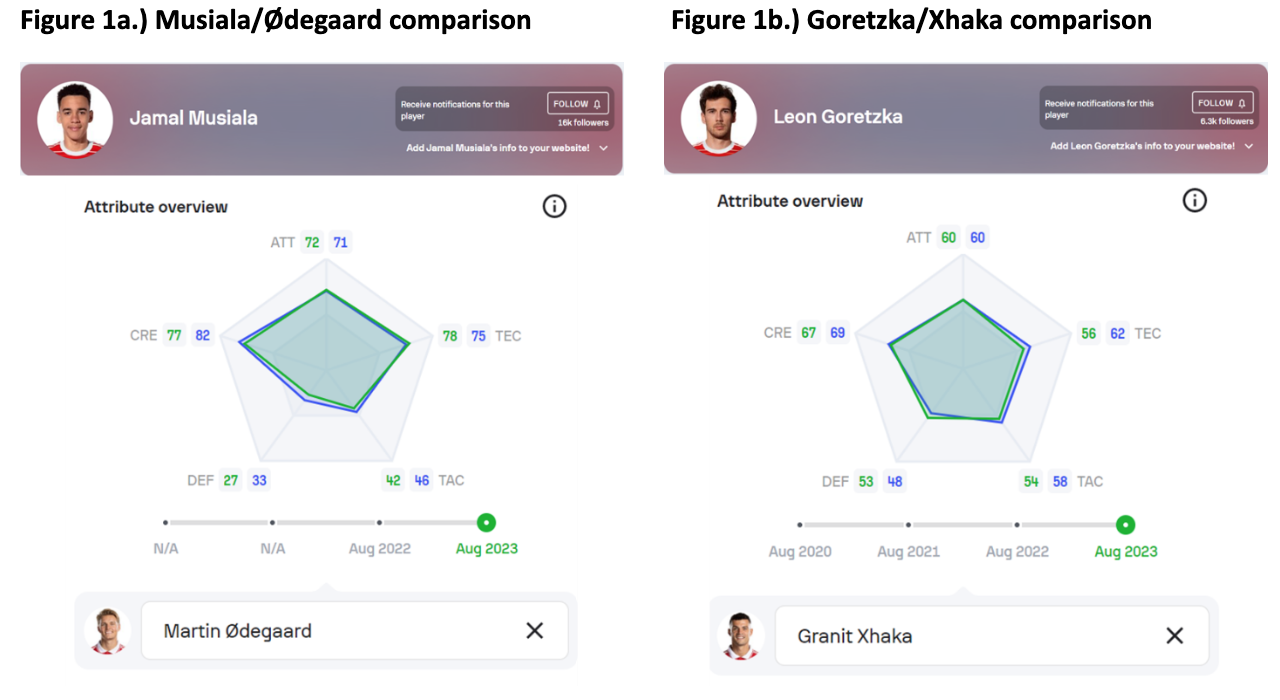
Bayern-Arsenal Analogue: Similar Strengths
Musiala and Ødegaard were both leading figures for their clubs in terms of offensive productivity, finishing the season first and second in league goal contributions for Bayern and Arsenal respectively. Like Ødegaard, Musiala also often played a relatively free role in Bayern’s attack, allowed to roam in search of space to attack between opposition lines. However, despite their similar profiles, Ødegaard and Musiala exploit the spaces afforded to them in contrasting ways.
Ødegaard had a greater tendency to progress the ball and unlock opposing defenses with his passing, averaging 50% more progressive passes per 90 than Musiala. Musiala, on the other hand, was more likely to break down opposition defenses with his ball-carrying ability, averaging 50% more progressive carries and more than twice as many attacking take-ons as Ødegaard per 90.
Endowed with exceptional balance, close control, and the agility to beat defenders through changes of pace and direction, Musiala’s skillset made him a consistent creative outlet in Bayern’s attack. Musiala’s goal against FC Köln to secure Bayern’s league title on the last day of the season encapsulates his mercurial ability (see Figure 2).
He received the ball from Serge Gnabry at the edge of Köln’s box, pirouetting to control, then took one touch to clear his feet, stepping away from the closing defender before arrowing a low shot into the far corner. With Bayern scrambling to find a goal to salvage a subpar season, their 19-year-old maverick stepped up, as he had regularly throughout the year, to create something out of nothing.
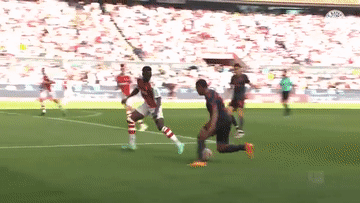
Figure 2: Musiala’s goal vs. Köln (video courtesy of FC Bayern Munich Matchday Center YouTube channel
As Figure 1b shows, Goretzka and Xhaka also brought similar attributes to their club sides in 2022/23. These similarities are demonstrated in their respective roles as well. Like Xhaka, Goretzka’s positional play served to support the more creative players in Bayern’s attack. His well-timed runs into half-spaces created options for Bayern’s wide players. The still below from the first leg of Bayern’s Champions League round of 16 encounter with PSG demonstrates this effect (see Figure 3).
Both Musiala and Goretzka (highlighted in yellow) push forward into the spaces between opposition fullbacks and centerbacks, forcing PSG’s fullbacks to narrow off and leaving Bayern’s wide players (highlighted in blue) ample space to operate in on the flanks. Arsenal’s incorporation of 8’s in their attack is strikingly similar to how Goretzka and Musiala were used at times under Julian Nagelsmann.
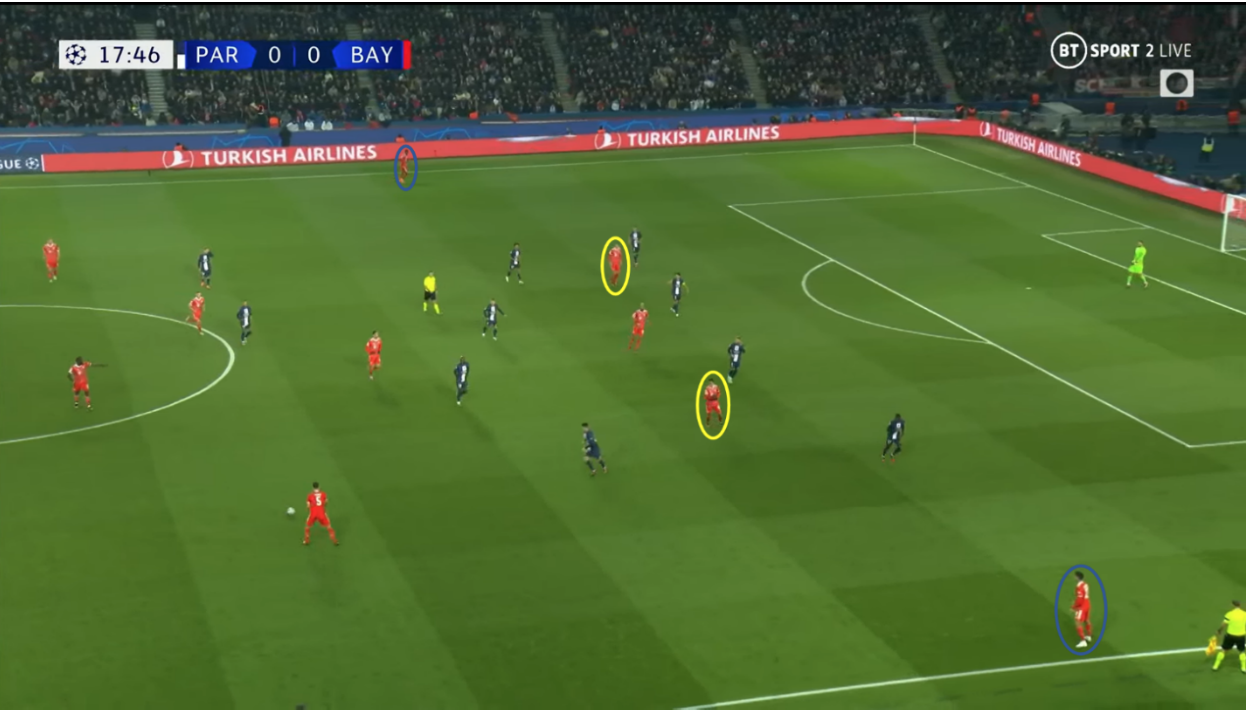
Figure 3.) Positional play of Bayern 8’s in attack
As a quick aside, the similar use of 8’s in Bayern and Arsenal’s approaches demonstrates one of the systemic advantages of deploying a box midfield in possession. Against both opposition’s back fours and back fives, the width of wingers in this system forces opposing wingbacks and fullbacks to be more disciplined defensively, as Bayern and Arsenal’s wide players are primed to exploit spaces vacated when wingbacks and fullbacks push forward.
It’s impossible to know, but it is plausible that increased interest in box midfields in the 2022/23 season was, at least in part, a tactical response to the increase in the use of wingback formations since the 2020/21 season. Playing with a wide front three supported by two attacking 8’s in half-spaces allows for similar width as is offered through wingback formations but in more advanced areas of the pitch. This is an effective way to pin opposition wingbacks in their own half and establish a territorial advantage without the need for specialist wingbacks to match up man-to-man.
Bayern-Arsenal Analogue: Similar Vulnerabilities
Like Xhaka, Goretzka also played a prominent defensive role in Bayern’s midfield. The importance of their respective defensive contributions stands out when analyzing games where Bayern and Arsenal struggled toward the end of last season. Bayern’s 3-1 loss at home to RB Leipzig and Arsenal’s 3-0 loss at home to Brighton, for example, showed how both Bayern and Arsenal were exposed defensively when their opponents were able to disrupt the defensive cover provided by Goretzka and Xhaka in midfield.
In Bayern’s loss to Leipzig, Tuchel’s side lined up in a defensive shape reminiscent of how Arsenal played out of possession for much of the season. Much like their counterparts Ødegaard and Xhaka, Musiala and Goretzka took on differentiated roles, with Musiala often stepping into the front line of Bayern’s defensive block alongside Thomas Müller, while Goretzka played as one of two holding midfielders screening Bayern’s defense. Leipzig were routinely able to play though Bayern’s defensive shape by working the ball around the front line of Bayern’s press into pockets of space on flanks, as demonstrated in the figure below.
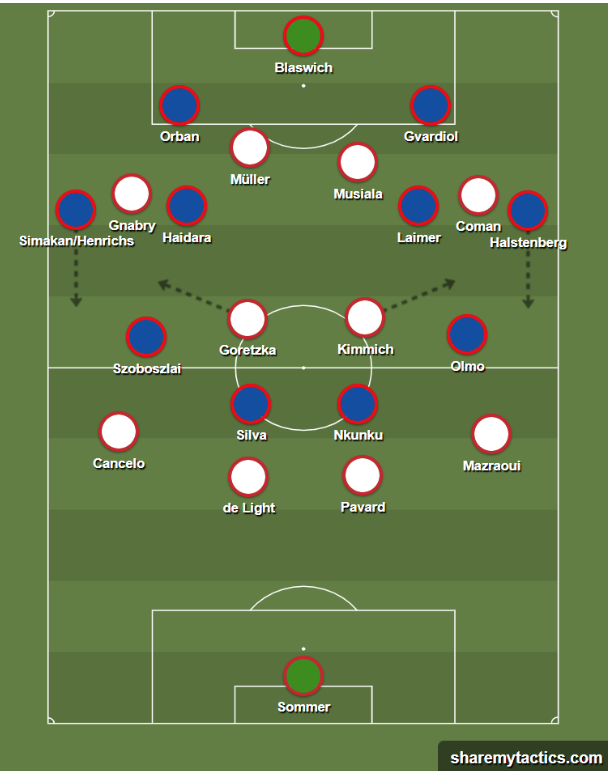
Figure 4) Bayern shape out of possession against RB Leipzig
These pockets of space were awkward zones to cover in Bayern’s shape. They were too deep for wingers Serge Gnabry and Kingsley Coman to cover, too wide for Bayern’s central holding midfielders (Kimmich and Goretzka) to occupy, and Bayern’s fullbacks were often reluctant to step forward to close those spaces as they were wary of the threat Leipzig posed with their pace in behind. This created a persistent defensive gap that Leipzig regularly looked to exploit.
As Leipzig players received the ball in that space, one of Bayern’s holding midfielders would often be forced to step out of the double pivot pairing and engage the Leipzig player on the ball. Leipzig players were quick to work the ball back into central areas where the remaining player in Bayern’s double pivot was now isolated, leaving the defense exposed.
While Leipzig were regularly able to move Goretzka out of his defensive covering position by pulling him into wider areas with their buildup, Brighton were able to effect a similar result against Arsenal by drawing Xhaka forward and playing into the space he vacated. Arsenal manager Mikel Arteta broke from his usual defensive approach for his side’s late-season clash with Brighton, as depicted in Figures 5a and 5b.

Figure 5a.) Xhaka’s positioning in a typical Arsenal defensive set-up

Figure 5b.) Xhaka pressing high and getting bypassed against Brighton
Xhaka was asked to press more aggressively, stepping out from the usual midfield double pivot, presumably in an attempt to stop Brighton from playing out from the back. This approach from Arteta backfired, as Brighton’s centerbacks would often bait Xhaka into pressing toward them only to immediately play the ball into the space he vacated.
As a consequence, Jorginho regularly found himself isolated as the sole protection in front of Arsenal’s defense, scrambling to recover as Arsenal’s defensive block was pried open. In yet another parallel between Xhaka and Goretzka, both players were subbed before the 70-minute mark in these matches as their sides succumbed to defeat. A tacit demonstration that when Goretzka or Xhaka struggled to affect games as they normally do, their sides often struggled as well.
Bayern-Arsenal Analogue: Points of Distinction
While Arsenal and Bayern’s use of their 8’s is very similar, their approaches depart from each other in other areas of the field. For instance, they often employed contrasting approaches to creating left-sided width in attack. Arsenal often looked to invert their left fullback Zinchenko, allowing him to dictate play from central areas in midfield. Bayern’s left fullbacks, Alphonso Davies and, to a lesser extent, Joao Cancelo, played as pseudo-left wingers, getting into advanced positions to drive Bayern forward down the left.
Comparing the heatmaps of Davies and Zinchenko shows this difference in their roles (see Figure 6). Davies’s touches are tighter to the touchline and show greater activity in the opposition’s final third, while Zinchenko’s are more concentrated away from the left touchline and in the middle third of the field.
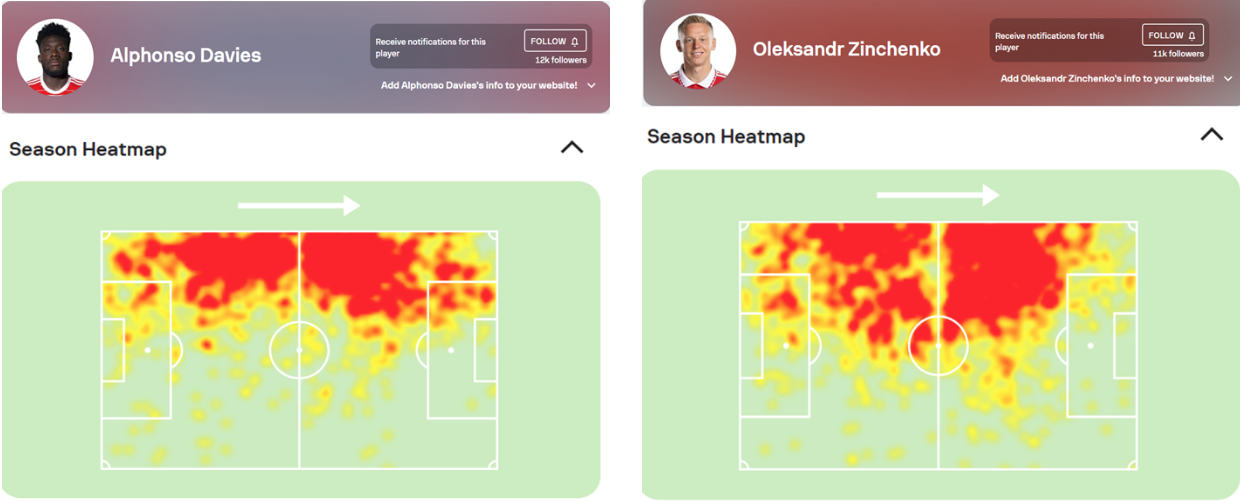
Figure 6.) Heatmap comparison of Bayern and Arsenal fullbacks [SofaScore]
This difference in approach to wide play cascades into more advanced areas of the pitch. With Davies or Cancelo providing width down the left side, Bayern’s left-sided attackers often tend to drift into more central areas. In Arsenal’s case, the opposite was true for the majority of last season, with Gabriel Martinelli holding the left-sided width in attack for Arteta’s team (though this dynamic would often shift whenever January signing Leandro Trossard played). These distinctions are once again visible when comparing the heat maps of Arsenal and Bayern’s left-sided forwards/wingers.
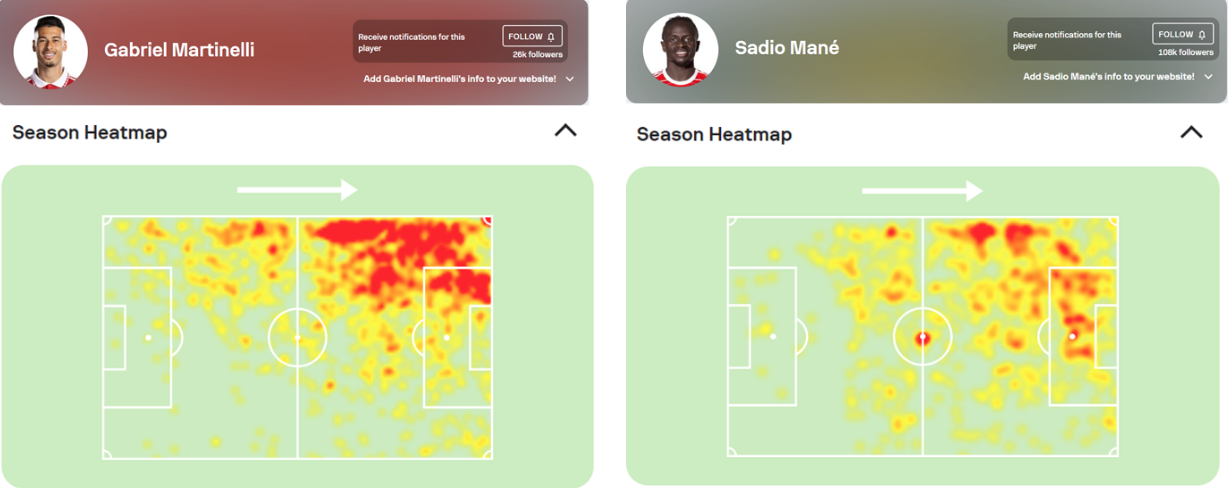
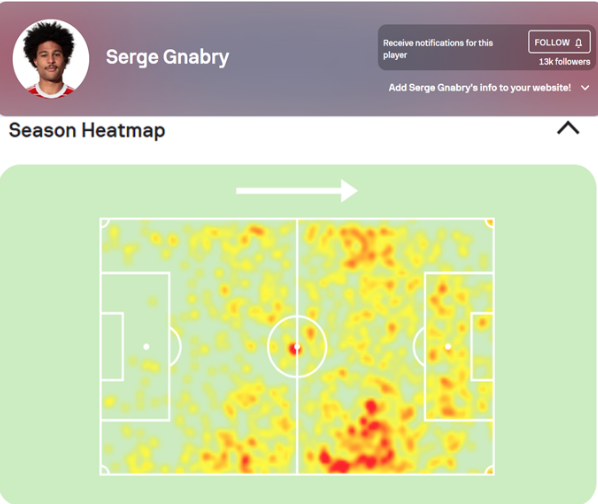
Figure 7.) Heatmap comparison of Bayern and Arsenal left wingers [SofaScore]
Bayern’s Rotation: Too Much of a Good Thing
Examining Gnabry and Sadio Mané’s season heatmaps sheds light on another unique facet of Bayern’s approach when compared to that of Arsenal in 2022/23. Both due to changes in the system over the course of the season and the nature of Bayern’s approach itself, Bayern’s attackers have less strictly defined roles than their Arsenal counterparts. Serge Gnabry is an excellent example of this as he played as both a right- and left-sided winger as well as a central forward at various points throughout Bayern’s season.
Musiala similarly shifted between roles as an 8, 10, and false 9 across matches and often within matches throughout the season. The adaptability of various attacking players in Bayern’s squad allows for this rotating of positions and when done effectively it can serve as a systemic strength of Bayern’s approach.
In Bayern’s 6-0 win over Schalke in May, for example, the continuous rotation between Müller, Gnabry, Leroy Sané, Coman and Musiala pulled Schalke’s defense apart. We saw Bayern at their best, featuring some gorgeous attacking interplay and a positional fluidity amongst Tuchel’s front five that proved too much for Schalke to handle on the day.
Bayern’s propensity for rotation does, however, come with its drawbacks. Particularly out of possession, this type of positional interchange requires exceptional coordination to avoid leaving gaps in defensive cover. Looking at the first goal Bayern conceded in their 3-0 loss at Manchester City in the Champions League quarterfinals shows an example of where this positional flexibility of roles may have been detrimental (see Figure 8).
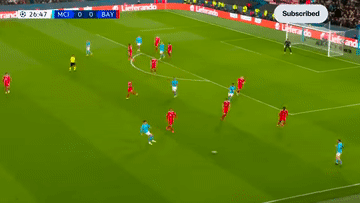
Figure 8.) Rodri’s goal against Bayern [courtesy of Manchester City’s YouTube channel]
Rodri’s goal comes as both City and Bayern are resetting after an initial City counterattack. When the City breakaway starts (not shown in the GIF) Musiala is occupying the role of center forward for Bayern. Gnabry tracks the initial run of Rodri, covering for Musiala in midfield. As the play resets, Gnabry leaves the midfield role to return to his usual forward position. Musiala, however, hasn’t yet rotated back into midfield.
This leaves City central midfielder Rodri in a pocket of space just outside the box. Musiala recognizes Rodri open in the space he’s responsible for covering and tracks back in an attempt to close Rodri down. Despite the effort, Musiala arrives late and is tackling from the wrong side, allowing Rodri to step around him and unleash a fantastic strike with his weaker foot into the top corner.
Musiala/Gnabry’s errors are subtle and only significant because of the fantastic skill Rodri produces after them, but such are the fine margins at the level Bayern aim to compete. So, while Bayern’s rotation may have allowed them to overwhelm teams with less individual quality throughout the 22/23 season, they’ll likely look to have less change and a more defined structure in challenging for major honors this upcoming season.
Having fallen to a 3-0 defeat to RB Leipzig in the DFL-Supercup, Bayern kicked off the Bundesliga season with a 4-0 win against Werder Bremen with Mathys Tel grabbing a goal, Leroy Sané recording a brace, and club-record signing Harry Kane marking his full debut with a goal. They’ll be looking to make it two out of two to start their title defense as they host Augsburg on Sunday before traveling to Gladbach.
By: Ade Samuel / Linkedin: https://www.linkedin.com/in/ade-samuel-42a165172/https://www.linkedin.com/in/ade-samuel-42a165172/
Featured Image: @GabFoligno / Alexander Hassenstein / Getty Images
*All statistics cited from fbref.com
